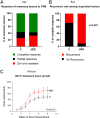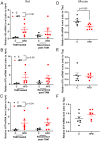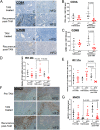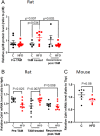Maternal obesity increases offspring's mammary cancer recurrence and impairs tumor immune response
- PMID: 32580156
- PMCID: PMC7424355
- DOI: 10.1530/ERC-20-0065
Maternal obesity increases offspring's mammary cancer recurrence and impairs tumor immune response
Abstract
Over 50% of women at a childbearing age in the United States are overweight or obese, and this can adversely affect their offspring. We studied if maternal obesity-inducing high fat diet (HFD) not only increases offspring's mammary cancer risk but also impairs response to antiestrogen tamoxifen. Female rat offspring of HFD and control diet-fed dams, in which estrogen receptor-positive (ER+) mammary tumors were induced with the carcinogen 7,12-dimethylbenz[a]anthracene (DMBA), exhibited similar initial responses to antiestrogen tamoxifen. However, after tamoxifen therapy was completed, almost all (91%) tumors recurred in HFD offspring, compared with only 29% in control offspring. The increase in local mammary tumor recurrence in HFD offspring was linked to an increase in the markers of immunosuppression (Il17f, Tgfβ1, VEGFR2) in the tumor microenvironment (TME). Protein and mRNA levels of the major histocompatibility complex II (MHC-II), but not MHC-I, were reduced in the recurring DMBA tumors of HFD offspring. Further, infiltration of CD8+ effector T cells and granzyme B+ (GZMB+) cells were lower in their recurring tumors. To determine if maternal HFD can pre-program similar changes in the TME of allografted E0771 mammary tumors in offspring of syngeneic mice, flow cytometry analysis was performed. E0771 mammary tumor growth was significantly accelerated in the HFD offspring, and a reduction in the numbers of GZMB and non-significant reduction of interferon γ (IFNγ) secreting CD8+ T cells in the TME was seen. Thus, consumption of a HFD during pregnancy increases susceptibility of the female rat and mouse offspring to tumor immune suppression and mammary tumor growth and recurrence.
Keywords: breast cancer; inflammation; local recurrence; tamoxifen therapy; tumor immune microenvironment.
Figures






Similar articles
-
Maternal obesity and resistance to breast cancer treatments among offspring: Link to gut dysbiosis.Cancer Rep (Hoboken). 2022 Dec;5(12):e1752. doi: 10.1002/cnr2.1752. Epub 2022 Nov 21. Cancer Rep (Hoboken). 2022. PMID: 36411524 Free PMC article. Review.
-
Genistein Reduces the Risk of Local Mammary Cancer Recurrence and Ameliorates Alterations in the Gut Microbiota in the Offspring of Obese Dams.Nutrients. 2021 Jan 11;13(1):201. doi: 10.3390/nu13010201. Nutrients. 2021. PMID: 33440675 Free PMC article.
-
Effects of Maternal Grape Juice Intake on Unfolded Protein Response in the Mammary Glands of Offspring of High Fat Diet Fed Rat Dams.Nutrients. 2020 Jul 28;12(8):2253. doi: 10.3390/nu12082253. Nutrients. 2020. PMID: 32731460 Free PMC article.
-
Maternal exposure to tamoxifen during pregnancy increases carcinogen-induced mammary tumorigenesis among female rat offspring.Clin Cancer Res. 2000 Jan;6(1):305-8. Clin Cancer Res. 2000. PMID: 10656462
-
EM-652 (SCH 57068), a third generation SERM acting as pure antiestrogen in the mammary gland and endometrium.J Steroid Biochem Mol Biol. 1999 Apr-Jun;69(1-6):51-84. doi: 10.1016/s0960-0760(99)00065-5. J Steroid Biochem Mol Biol. 1999. PMID: 10418981 Review.
Cited by
-
Emerging concepts in cancer therapy: Mechanisms of resistance.Cancer Rep (Hoboken). 2022 Dec;5(12):e1715. doi: 10.1002/cnr2.1715. Epub 2022 Sep 9. Cancer Rep (Hoboken). 2022. PMID: 36083019 Free PMC article. No abstract available.
-
Experimental models of endocrine responsive breast cancer: strengths, limitations, and use.Cancer Drug Resist. 2021;4(4):762-783. doi: 10.20517/cdr.2021.33. Epub 2021 Jul 8. Cancer Drug Resist. 2021. PMID: 34532657 Free PMC article.
-
Maternal high-fat diet increases the susceptibility of offspring to colorectal cancer via the activation of intestinal inflammation.Front Nutr. 2023 May 12;10:1191206. doi: 10.3389/fnut.2023.1191206. eCollection 2023. Front Nutr. 2023. PMID: 37252240 Free PMC article. Review.
-
Maternal obesity and resistance to breast cancer treatments among offspring: Link to gut dysbiosis.Cancer Rep (Hoboken). 2022 Dec;5(12):e1752. doi: 10.1002/cnr2.1752. Epub 2022 Nov 21. Cancer Rep (Hoboken). 2022. PMID: 36411524 Free PMC article. Review.
-
Aromatics from fossil fuels and breast cancer.iScience. 2025 Mar 10;28(4):112204. doi: 10.1016/j.isci.2025.112204. eCollection 2025 Apr 18. iScience. 2025. PMID: 40212587 Free PMC article. Review.
References
-
- Bakin AV, Rinehart C, Tomlinson AK, Arteaga CL. 2002. p38 mitogen-activated protein kinase is required for TGFbeta-mediated fibroblastic transdifferentiation and cell migration. Journal of Cell Science 115 3193–3206. - PubMed
Publication types
MeSH terms
Grants and funding
LinkOut - more resources
Full Text Sources
Medical
Research Materials

